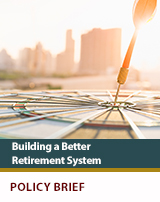POLICY BRIEF: What Does it Take to Build a Better Retirement System?
KEY POLICY INSIGHT: With the largest generation of pensioners in U.S. history heading for life after work, the stress on all manner of retirement plans grows more obvious by the year. The greatest good for the greatest number – past, present and future – demands changes in behavior by young and old. Fresh strategies for government and private enterprise are needed. A few states and several other countries offer models to
emulate.
Problems and solutions in pension planning were explored by experts at an April 23rd seminar at the University of Minnesota. They included Kurt Winkelmann, senior fellow of pension policy at the University of Minnesota; Greg Mennis, director of Public Sector Retirement Systems at the Pew Charitable Trusts; and Jeff Bailey, lecturer at the Carlson School of Management and former senior director of benefits for Target Corp. The panel was moderated by Chris Farrell, economics commentator for Minnesota Public Radio and senior economics contributor for American Public Media’s Marketplace radio show.
LOOKING AHEAD
“The ultimate metric, at least as far as I’m concerned, is having a sustainable system so the fewest people are without an actual retirement benefit,” Winkelmann said.
A few states may have arrived at a formula for meeting that goal.
“Through a lot of our work, we’re trying to shift attention to ‘What are states doing right?’” Mennis noted.
Wisconsin, Tennessee, and South Dakota managed to create public pension systems that remained fully funded over the last two decades and two recessions, he said.
“(They) do a particularly good job of managing risk and also do a particularly good job of providing retirement savings across the workforce, not just the people who retire with a full pension but also the teacher who may work five or 10 years and then go down a different career path,” Mennis said.
California has developed a state-sponsored pension program specifically targeted to lower- and middle-class workers.
“We talk so much about underfunded pensions and the challenge of a federal solution,” Mennis said. “Now we’re shifting our attention to the states that are doing things right on the public side and the idea that state-sponsored plans can solve some of these problems we’ve been struggling with.”
Wisconsin and Tennessee have set aside enough to pay all their public pension obligations, while enforcing carefully designed risk-management policies that govern plan investments.
But those two states also stand out for another reason: They set a default savings rate of 12 percent or more for public workers, Mennis observed.
“If you look at the public “defined benefit” system and the corporate “defined contribution” system, they’re basically trying to solve the same problem.” Winkelmann said. “Yet at the root, neither system really has enough money.”
Putting more money aside for retirement doesn’t solve all the risks associated with pension funds – both “defined benefit” plans that promise a set amount of monthly payments for life and “defined contribution” plans that put the burden on workers to save for the future – face a number of hazards.
INVESTMENT RISK
Will the money set aside by employers in “defined benefit” plans or by workers in “defined contribution” plans grow fast enough to cover years or decades of retirement expenses?
“Right now, I’d say 95 to 99 percent of 401K savers have absolutely zero idea how their wealth accumulation might translate into lifetime income,” Bailey said.
Farrell said Federal Reserve figures show that the median savings for 401K and individual retirement accounts is $135,000. That amount, he said, would leave beneficiaries with a typical lifetime income of $600 a month.
“If people had that estimate, I think they might change their saving behavior,” Bailey said.
Winkelman observed that 401K plans have shifted two burdens from employers to workers. “The first is making sure they save enough,” he said. “The second is any risk in what happens to investment returns. They (employers) are basically off the hook.”
The absence of knowledge about where to invest their retirement savings – and how to gauge their own tolerance for financial hazard – plagues many workers.
“The challenge has been, across the board, what do people look to for advice, in terms of building better portfolios and better investment solutions?” Winkelmann said.
Bailey echoed the theme: “People right at retirement age are probably the most vulnerable of all. They have really no future employment options. They have to have some investment policies. Are they going to be aggressively invested? Not aggressively invested?”
MORTALITY RISK
How many years will a beneficiary live after retirement? Long life is a blessing until it becomes a financial peril.
“In some ways that’s the biggest issue,” Bailey said. “Even if someone is successful in building up a large nest egg for retirement, they reach 65 and are left with a decision about what to do with it (their savings).”
How much money should even the most diligent savers in “defined contribution” plans draw down every year in retirement? Many pensioners haven’t a clue.
Each of the panelists agreed that pension investment advice for future beneficiaries often leaves workers befuddled. Employers themselves may have a muddled view of their role in making choices clear.
“If you went to most companies and asked them ‘What’s the mission of their 401K plan?’ they really wouldn’t have an answer,” Bailey said.
“If you turn it around when ‘defined benefit’ plans were more popular and more common, it was pretty easy to say what the purpose of the ‘defined benefit’ plan was,” he said. “That it was designed to provide sustainable income over a lifetime for individual participants in the plan.
“‘Defined contribution’ plans don’t have that sort of mission,” Bailey concluded. “They’re essentially wealth accumulation and that’s kind of the end of it.”
TRANSPORTABILITY LIMITATIONS
Even workers covered by generous “defined benefit plans” – these days, mostly government workers – can lose a substantial amount of retirement protection by jumping jobs.
At Target, where Bailey once oversaw both “defined benefit” and “defined contribution” plans, only about a third of the company’s 300,000 workers were eligible for the pension programs. As with many companies, part-time workers were left out.
“Where those (other) folks went to ultimately create savings for themselves is open to question,” Bailey said. “I think the likely answer is they didn’t go anywhere.”
Some government plans respond to that challenge.
“Wisconsin has a fund that not only allows the employee to take what they’ve been taking from their paycheck but also what the employer has been contributing,” Mennis said.
LESSONS FROM OVERSEAS
Other nations can offer examples of what to do right in pension policies.
In the United States, public pension funds often make unrealistic estimates of how much needs to be saved now to pay for benefits later, Winkelmann said.
In contrast, the Dutch avoid making overly optimistic assumptions by tying their assumptions of needed returns to reallife examples of how to price – in today’s money – promises of pension payments years away.
“To make sure there’s enough money in the fund, they use a market interest rate to value how much money they need on the benefits side,” Winkelmann said.
Meanwhile, the Dutch central bank – serving as a kind of independent regulatory body – sets the assumptions of public pension plans.
“It’s not that the Dutch central bank is immune from political pressure from the funds themselves,” Winkelmann said.
“Nevertheless, it’s kind of an independent, respected entity that says, ‘Right, you need to discount your liabilities at this rate.’ It’s an observable market rate. By the way, if you’re underfunded, here’s what you have to do in terms of taking risk in a portfolio.”
The Dutch, he said, also introduced the idea of risk-sharing across generations. Changing conditions can alter how much is set aside for retirement, as well as what retirees can expect to
collect one day.
“Contingent on the level of funding, there’s a rule that governs what happens to retirement benefits – possible variability,” Winkelmann said. “And there’s a rule that governs contributions by people who are currently working.”
In Australia, where “defined contribution” plans prevail, the amount set aside for retirement is clear and obvious.
“If you read about job posting, here’s the salary and here’s the contribution to the superannuation trust,” Winkelmann said.
U.S. pension plans could take a lesson from Australians, about making contributions automatic, and from the Dutch, in curbing investment risks.
State insurance regulators already set clear rules on private annuity plans. How much risk they can take is limited. Why not apply such standards to private pensions?
“There are rules…but for whatever reason we have not figured out how to apply them to the pension system,” Winkelmann said.
One danger from under-funded public pensions extends well beyond obligations to be paid years or decades from now. That risk is that pension promises will take significant money away from core government services – from education to filling potholes.
“In 2000, on average, public systems, believe it or not, were about 100 percent fully funded,” Mennis said.
“Since that time, we’ve seen this enormous disparity between the well-run and the poorly-run systems.”
Properly managed state pensions may claim only three or four percent of all state revenue. Poorly managed funds, like those of Illinois or New Jersey, could demand 15 to 20 percent of the balance of state treasuries.
“That’s a staggering amount,” Mennis said.
In the private pension arena, panelists agreed that employers must do a better job of educating workers about how much they need to save and what choices they have for investment.
But companies, in Bailey’s view, should take a broader approach to helping employees through times of financial stress – not only as they approach retirement but in their 20s, 30s, and 40s. Those are the years when people are grappling with college debt, credit card payments, and saving to buy a home.
“There are different times in peoples’ lives when they’re willing to focus on particular financial problems,” Bailey said.
“Employers have to be more willing to address the financial lifecycle position of their employees,” he said. “They can do a lot better by helping relieve financial stress (rather than) leaving them trying to solve all these other problems besides just retirement.”
PANELISTS:
JEFF BAILEY is a finance lecturer in the Carlson School of Management and the former senior director of benefits for Target Corporation. In his role, Jeff supervised the investment programs and funding, plan design, and administration of the company’s defined benefit and defined contribution plans, non-qualified retirement plans, leave and disability plans, life insurance plans, medical plans, and time off plans.
GREG MENNIS is the director of public sector retirement systems at The Pew Charitable Trusts. The project provides cutting-edge research on pension and retiree health promises and helps states and cities undertake evidence-based pension and retiree health care reforms. Prior to joining Pew, Greg was the assistant secretary for fiscal policy in the Massachusetts Executive Office for Administration and Finance, where he was responsible for retirement benefits policy, long-term fiscal planning, and the state’s Pay for Success financing program.
KURT WINKELMANN is a Senior Fellow at the University of Minnesota where he leads the Heller-Hurwicz Economics Institute’s Pension Policy Initiative. He is also founder and CEO of Navega Strategies, LLC. Prior to starting Navega, he was managing director and Global Head of Research at MSCI and a managing director at Goldman Sachs Asset Management. Kurt earned his Ph.D. in economics at the University of Minnesota, and is the chair of the Heller-Hurwicz Economics Advisory Board.
CHRIS FARRELL is a senior economics contributor at National Public Radio’s Marketplace, an economics commentator for Minnesota Public Radio, a regular contributor to the Minneapolis Star Tribune, and the author of several books on retirement.




